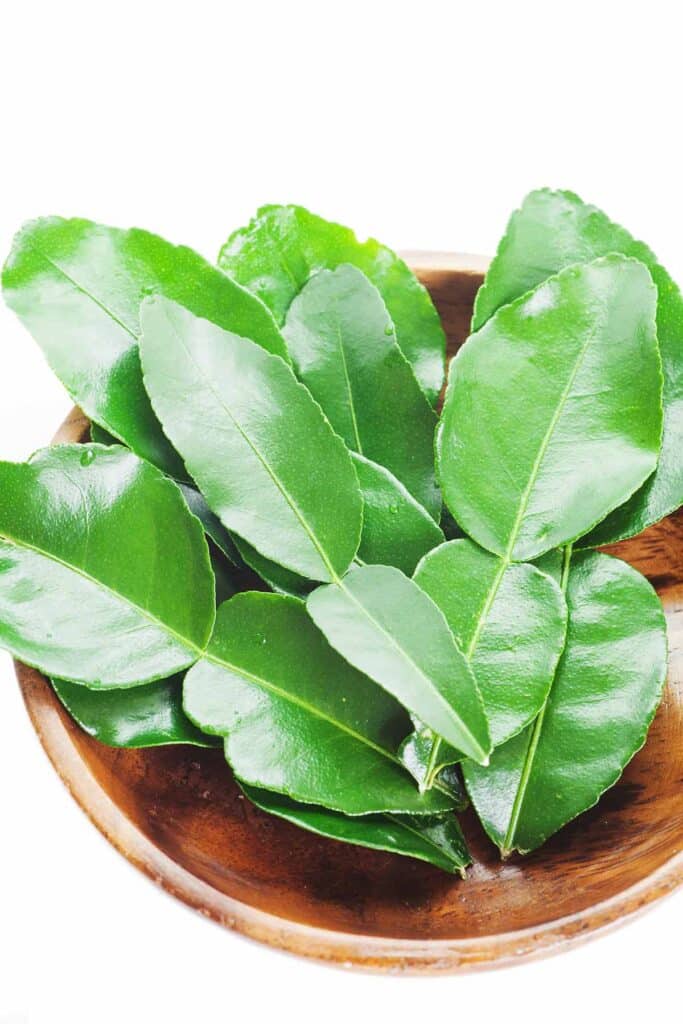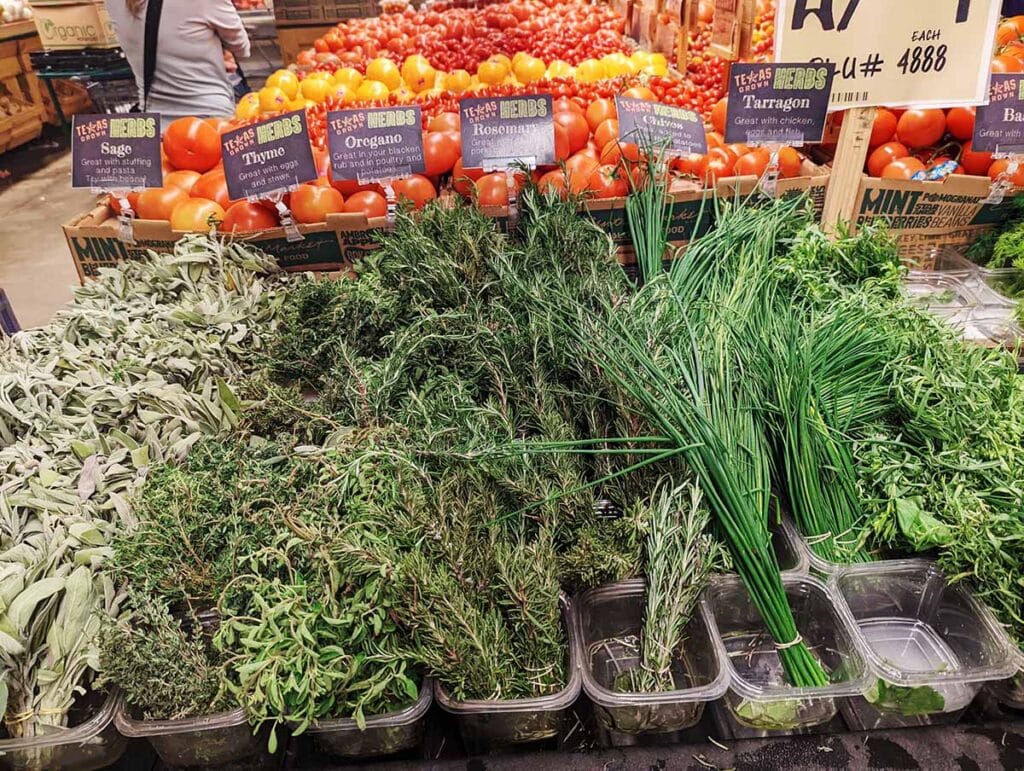In this article, we will tell you about your options for a kaffir lime leaves substitute. After all, finding these leaves can be a daunting task if you’re not in Southeast Asia.
From easily accessible citrus options to a mix of herbs, there are many alternatives you can use to replace kaffir lime leaves. Read on and discover how you can still cook your recipes even without these leaves.

Kaffir lime leaves boast a pleasing citrusy scent and a combination of lemony and floral flavors.
They come from the Kaffir lime tree (Citrus hystrix).
People commonly use it in Thai, Indonesian, and Malaysian cuisine. These glossy, dark green leaves add a zesty taste to curries, marinades, soups, and stir-fries.
They have a potent citrus aroma, so people use them whole or shredded to infuse dishes with their scent.
The leaves of kaffir limes are indispensable in dishes like Tom Yum soup, rendang, and green curry. They also go by the name makrut lime leaves.
Kaffir lime leaves are conjoined, so they resemble a figure eight. For this reason, people also use these leaves to add aesthetic appeal to dishes.
If you do not have kaffir lime leaves, you can still recreate your favorite Asian recipes. You just have to use the best alternatives of Kaffir Lime Leaves to mimic some of the properties.

Lime zest is an excellent substitute for kaffir lime leaves, offering a viable option in their absence. Lime zest, known for its distinct citrusy taste, is also popular in Asian cuisine.
This substitute can replicate the flavor of kaffir lime leaves and work best in baked goods.
The good thing is that it is very easy to get the zest of a lime. You can use a grater or a knife to carefully obtain the zest without getting the pith.
Tips:
Using too much lime zest can overwhelm your dish. Substitute 2 kaffir lime leaves with ¼ teaspoon lime zest for the best results.

Lime juice is also a kaffir lime leaf swap you can use in certain dishes. It is a liquid alternative, so it will affect the texture of your dish.
That said, lime juice only works when making soups, marinades, and curries.
Limes are also easily available, so lime juice makes a quick replacement if you’re in a pinch.
Tips:
For the best results, use the juice of Persian limes. They have the closest flavor, and these limes are usually seedless. You won’t have to worry about straining the liquid to remove the seeds.

Lemon zest is another viable alternative to kaffir lime leaves. While not as potent, it still can give a citrusy aroma to the dish.
For this reason, you are better off using it than just leaving out the leaves altogether.
Although not identical in flavor, lemon zest imparts a citrusy taste that adds vibrancy to any dish. Moreover, lemon is more readily available in grocery stores.
Tips:
To replace every 2 leaves, use 1/4 teaspoon of lime zest. If you find the flavor lacking, use some coriander to achieve a more complex taste.

Preserved lemons might not immediately come to mind as kaffir lime leaves substitute. However, these lemons are great alternatives.
Through the pickling process, the lemons develop a unique flavor. With the help of vinegar and salt, they become more tart than regular lemons.
For this reason, they make a worthy alternative to kaffir lime leaves. Preserved lemons taste great with shrimp or fish. Preserved lemons are your best bet if your dish has any of these ingredients.
Tips:
To replace a single stalk of makrut leaves, use 1/4 teaspoon of chopped preserved lemon. It is crucial to note that preserved lemons already contain salt. That said, reducing the additional salt used in your dishes is best when opting for preserved lemon as a substitute.

Lemon thyme is a good alternative to kaffir lime leaves, thanks to its citrusy flavor profile. This herb has a strong lemon scent and a pungent taste, which makes it stand out from regular thyme.
It may not perfectly replicate the exact flavor of kaffir lime leaves. Still, it remains a worthy substitute.
After all, lemon thyme has a reduced bitterness compared to regular thyme. For this reason, you can use it generously without overpowering the dish.
Tips:
Lemon thyme works best as kaffir lime leaves replacement in soups, stews, fish, and meat dishes. You may even use them in salads.

Curry leaves can also be a decent swap kaffir lime leaves. However, they will only work when preparing Indian dishes.
After all, they don’t possess the sharp and pungent citrus flavor of kaffir lime leaves. Using them will result in a less intense taste. Still, they can contribute exceptional taste, particularly to Indian curries and rice dishes.
Tips:
Remember to remove the curry leaves after cooking. Unlike kaffir lime leaves, they are not edible.

Bay leaves can also be a great option to replace kaffir lime leaves in recipes. They provide a comparable level of pungency and are perfect for savory dishes.
It’s important to note, though, that bay leaves do not taste like kaffir lime leaves. Rather than having citrus notes, bay leaves are actually floral.
Nevertheless, bay leaves still do well in soups, stews, and sauces.
Tips:
Combine bay leaves with lime or lemon zest to enhance the flavor. This combination works particularly well in recipes like Thai curry paste.

Another excellent swap for kaffir lime leaves is orange peel. These citrus peels offer a comparable savory aromatic essence to recipes.
Of course, orange peels do not look anything like kaffir lime leaves. For this reason, it may make your dish look different. It is still a great option, though, as they can deliver a similar flavor.
However, it is important to use the peel sparingly. An excessive amount can introduce bitterness to your dish.
Tips:
Be sure not to include any white pith. The pith can have a bitter taste as well, and it can also affect the texture of your dish.

Lemongrass is among the best kaffir lime leaves substitutes. When you crush lemongrass stalks, you will get a burst of citrus aroma. This scent is very similar to kaffir lime leaves.
It’s crucial to note that lemongrass is tougher, so you must cook it longer to benefit from it.
Another advantage of utilizing lemongrass is its relatively mild taste. This mild flavor allows for a slight margin of error if you add too much. It won’t significantly affect the overall balance of your recipe.
Tips:
One stalk of fresh lemongrass can replace 3-4 kaffir lime leaves. If you only have dried lemongrass, use a teaspoon of it as a substitute for 3-4 makrut lime leaves.

An herb mix can serve as a fantastic kaffir lime leaf substitute. By combining specific ingredients, you can create a swap that captures the essence of kaffir lime leaves.
The bay leaf imparts its distinctive herbal notes, while the whole lime contributes a zesty and citrusy tang. The fresh lemon thyme further enhances the mix with its aromatic lemon flavor.
Tips:
Combine lime, bay leaves, and fresh lemon thyme. Blending these components yields a flavor profile that closely mimics kaffir lime leaves. Adjust the amount of herbs to get your preferred flavor.

Basil, specifically Thai basil, is an ideal swap for kaffir lime leaves, especially in Southeast Asian cuisine.
Its distinct flavor and aroma make it a perfect choice for recipes that traditionally call for kaffir lime leaves.
The good thing is that Thai basil does not only work in Thai cooking. It also tastes great in recipes from other parts of the world.
These leaves also look good as a garnish. They may not look like kaffir lime leaves, but they have their aesthetic appeal.
Tips:
To further enrich Thai basil’s flavor, use it with cilantro and mint. This blend of herbs adds multiple layers of flavor, making it a better alternative.

Lemon balm, a member of the mint family, is an excellent alternative to kaffir lime leaves, too. These leaves introduce a refreshing and citrusy touch to your culinary creations.
Like fresh kaffir lime leaves, lemon balm is a mainstay in Asian cuisine. For this reason, it will work in most dishes that call for kaffir lime leaves.
Tips:
When substituting kaffir lime leaves with lemon balm, it’s crucial to consider the herb’s potency. Lemon balm has a stronger flavor. For this reason, use half the amount of lemon balm as the kaffir lime leaves your recipe requires.
People often associate kaffir lime leaves with lime due to their name, but their taste is not exactly like lime. They do share some citrusy notes. However, kaffir lime leaves offer a distinctive flavor profile that combines citrus, floral, and bitter elements. Lime is mostly just tangy and citrusy. That said, kaffir lime leaves have a more complex taste than lime.
Asian grocery stores are the best places to look for these leaves. If you do not live near Asian stores, you may buy them from online platforms.
Absolutely! You can still make a delicious green curry without kaffir lime leaves. While kaffir lime leaves impart a unique flavor to the dish, they are not irreplaceable. One option is to substitute lime zest and a small amount of lime juice to replicate the citrusy essence. Adding other fresh herbs, such as basil or cilantro, enhances your curry’s aromatic and herbal notes.
Finding kaffir lime leaves outside Southeast Asia can be challenging. There is no need to fret, though. There are several viable alternatives you can use instead. Lime zest and lime juice prove to be excellent substitutes. They deliver a citrusy flavor that works well in baked goods, soups, marinades, and curries.
For a citrusy aroma, turn to lemon zest or lemon preserves. Other options for kaffir lime leaves substitute include curry leaves for Indian cuisine and bay leaves for savory recipes. Though makrut lime leaves boast complexity, these alternatives ensure that recreating your favorite dishes remains a flavorful endeavor.





